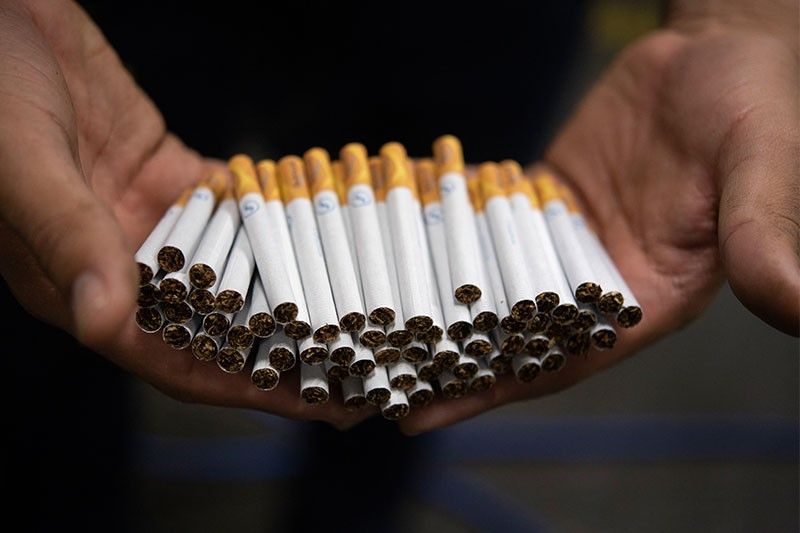Commentary: How the tobacco industry wrote the ‘fake news’ playbook

In case you didn’t know, there’s a website dedicated to 14 million documents that expose the tobacco industry’s history of lying, manipulation and propaganda.
The Truth Tobacco Industry Documents , formerly known as the Legacy Tobacco Documents Library (housed under the University of California, San Francisco) contain internal corporate documents produced as part of a lawsuit brought by US States against seven major tobacco industry organizations between 1994 and 1998.
The States asked the industry to reimburse health care expenditures related to tobacco-related illnesses. The tobacco companies were forced to pay large sums of money to the States, after years of trying to hide industry documents. They also lied under oath about the addictive nature of cigarettes. The master settlement agreement from this litigation required millions of tobacco industry internal documents to be made public.
The Truth Tobacco Industry Documents Library is part of a larger archive that includes documents on drugs, food, fossil fuel, and chemicals: all industries that influence public health. The tobacco industry is noteworthy, however, for consistently being cited as the author of the post-truth playbook, and for being the most successful example so far of how to utilize emotion, misdirection, and propaganda to trump facts and hard science.
For the tobacco industry, disinformation, propaganda and 'fake news' are tried-and-tested tactics and strategies merely rehashed for modern audiences. They successfully confused, manipulated, and lied to the public then; here’s how they’re doing it now.
Step 1: Hire PR agencies
When epidemiologists in the 1950sbegan to clearly link cigarettes to cancer, it seemed the tobacco industry was finished. Readers’ Digest in 1953 even published a landmark article about it, titled “Cancer by the carton.”
At that time, the tobacco industry—which engaged doctors in its ads then and already knew the dangers of smoking by its own research—could have at least acted in precaution and stopped promoting cigarettes.
But what they did instead was hire a PR agency. They met with PR agency Hill & Knowlton in 1953, where PR guru John Hill suggested a simple public relations strategy that proved to be effective for years to come: establish confidence and create public reassurance during that interim when “scientific doubts must remain,” the end goal of which was “to free Americans from the guilty fear that is going to arise deep in their biological depth… every time they light a cigarette.”
They capitalized on guilt—an all-too-common emotion—and responded with confidence and reassurance. “A Frank Statement to Cigarette Smokers” is one such example.The advertising statement released by tobacco companies on 1954 spun the issue by reassuring the public (“We believe the products we make are not injurious to health”), casting doubt on the links to cancer (“These experiments [on mice] are not regarded as conclusive in the field of scientific research”), and by casting the tobacco companies as concerned stakeholders even as they deny scientific claims (“We always have and always will cooperate closely with those whose task it is safeguard the public health”).
Today, tobacco companies are working hard to rehabilitate their reputations. Philip Morris International’s (PMI) current campaign says itis designing a “smoke-free” future. Another campaign, in the context of IQOS (a heated tobacco product), says “this changes everything” (trademarked). PR agencies still partner with tobacco companies to brainstorm modern and creative ways to get this message across. The head scratcher: they still organize parties, concerts, and other promotions to continue selling cigarettes.
PMI’s recent white paper also discusses “Trust in a COVID-19 world”. It states: “We understand that many people trust neither Philip Morris International (PMI) nor the tobacco industry in general…we accept that earning trust will take time.” The white paper noticeably fails to mention why people lost trust in the first place: because Big Tobacco has failed to live up to its promise in 1954 that if they “had any thought or knowledge that in any way we were selling a product harmful to consumers, we would stop business tomorrow.”
Tomorrow? The harm has been long established, and it’s 2021.
Step 2: Form front groups
As stated in the Truth Tobacco documents, Hill & Knowlton’s strategy for crisis management included the formation of a Tobacco Industry Research Committee (TIRC),comprised of scientists and educators. This committee was no more than a PR strategy. One of the committee’s goals was “to bring public attention to the fact that there is now no conclusive proof that cigarette smoking is a cause of lung cancer and other serious problems of human health.” This it did through the publication “Tobacco and Health,” which was delivered to 500,000 doctors and scientists, and had one key message: “the anti-cigarette theory has not been really proved.”
“No conclusive proof”? “Not really proved”? It was 1954, and by then, the evidence was overwhelming against cigarette smoking and its confirmed link to cancer, a matter recognized even by national government agencies. Not only this, in the years following the creation of the committee, tobacco industry scientists had also confirmed the causal link between smoking and cancer.
The TIRC was also tasked to “reassure” the “millions of people who derive pleasure and satisfaction from smoking… that every scientific means will be used to get the facts as soon as possible.” Yet the tobacco industry subsequently admitted the TIRC “did not look right” as it made ‘partisan’ arguments on behalf of the industry and simultaneously sponsored research that was supposedly objective. Thus, tobacco companies agreed to form The Tobacco Institute, a separate organization for information and PR purposes.
Today, the tobacco industry has pervasively expanded its influence beyond research committees. However, documenting these front groups remain a challenge because corporate transparency in matters of public interest is not yet the norm. But to start, this journal article lists front groups and third parties documented to have received tobacco industry funding for operations in Southeast Asia, and government entities with conflicts of interest with the tobacco industry.
Spoiler alert: the Philippines’ Inter-Agency Committee-Tobacco is in the list.
Step 3: Take advantage of ignorance and doubt
The study of how ignorance is produced deliberately is called “agnotology.”It was coined by Robert Proctor, a Stanford University historian, whose field of study was started by his observations of the tobacco industry.
Think about that for a while: the tobacco industry inspired studies on how ignorance and doubt are deliberately produced in society.
In the Truth Tobacco documents, there’s amemo where a tobacco company executive proposes a new strategy to “improve the case for cigarettes” in 1969, wherein doubt is a “product,” and “truth” is a mere message:
“Doubt is our product since it is the best means of competing with the ‘body of fact’ that exists in the mind of the general public….Doubt is also the limit of our ‘product’. Unfortunately, we cannot take a position directly opposing the anti-cigarette forces and say that cigarettes are a contributor to good health. No information that we have supports such a claim.”
And on using one instance of “truth” to “dominate” controversy:
“Truth is our message because of its power to withstand a conflict and sustain a controversy. If in our pro-cigarette efforts we stick to well documented fact, we can dominate a controversy and operate with the confidence of justifiable self-interest.”
The memo goes on to outline next steps: using “test markets” and employing surveys to measure public opinion, so the tobacco company can recalibrate—not the contents of their products—but their cigarette ads.
Today, tobacco companies exploit their delayed admission that cigarettes are harmful, even if this has been established more than 60 years ago. That fact is the “truth” part of their current messaging—yes, cigarettes are harmful. But this admission is always followed by a promotion, among others, for their heated tobacco products (HTPs), which they say is “a better alternative to smoking” (even as they also know that the best choice is to quit, or not smoke at all). They create doubt today on how the public should perceive their new products, which is evident when one compares PMI’s statements to the US FDA’s statements on IQOS, for example:
- PMI’s press release on the US FDA allowing the sale of IQOS focuses on how this is a “public health milestone,” even if…
- The US FDA took pains to say that even as it authorized the marketing of IQOS as “modified risk tobacco products” to see if it will benefit the health of the population, these products are “not safe nor FDA approved.” The US FDA even added that: “It is important to note that these products are not safe, so people, especially young people, who do not currently use tobacco products should not start using them or any other tobacco product”(emphasis by the US FDA).It is important that PMI was also required to conduct postmarket surveillance and studies to determine whether this authorization continues to be appropriate, including assessing the potential for increased use among the youth.
If one carefully studies the US FDA statements and what they stress as compared to the PMI press release, one can see how the latter spins the former. While it is true that the US FDA allowed the marketing of IQOS as modified risk tobacco products, PMI immediately jumped the gun and spun this as a “public health milestone,” creating doubt on whether the products are harmful or not (it is, says the FDA). The inevitable result is confusion. Confusion causes delay, and this delay allows the tobacco industry to get ahead and increase its profits.
There is no public health milestone here, as the products are clearly not safe. Remember: the true public health milestone would’ve been Big Tobacco fulfilling its promise to stop selling cigarettes.
Is doubt still the product of the tobacco industry? Yes.For more information on how it markets its new products to confuse the public, see the report on PMI’s “Smoke-Free World” campaign and its next generation “harm reduction” products, titled “Addiction at any cost.” A notable finding is how PMI is using the term “smoke-free” to confuse the public, such as when it co-opts grassroots movements pushing for legislation for truly smoke-free environments (e.g., the Philippine Smoke-Free Movement).
Step 4: Distract and trivialize
The tobacco industry has bombarded the media with press releases and “expert” opinions meant to sway public opinion on cigarettes and “harm reduction” or “reduced risk” products.
Advocates of the industry frequently distract and trivialize issues. A recent example of distraction and trivialization: a harm reduction advocate discrediting the World Health Organization and the Department of Health and twisting the rules on foreign aid, in order to place the tobacco industry in a better light. The industry, to distract from its own conflict of interest with public health, invents conflicts of interest.
It is easy to be captivated by these tactics and strategies, until we are reminded of the bottomline: millions of human lives, and billions in healthcare costs, lost over tobacco-related diseases, while the industry concocts the next best strategy to sell more cigarettes and other harmful products.
The truth is boring, but it is the truth nonetheless: the tobacco industry, as long as it sells and promotes cigarettes and smoking, can never claim that it prioritizes public health.
It boils down to trust. The lies, the propaganda, and the deceitful manipulation are not things of the past for the tobacco industry. Because it continues to sow doubt, manipulate emotion, and play around with public opinion—reflecting the problem of ‘fake news,’ disinformation, and propaganda today—I don’t trust the tobacco industry.
Do you?
__
Anna Bueno is a lawyer and a policy associate for ImagineLaw, a public interest law firm advocating for healthy and meaningful lives. Parts of this article are informed by inputs from the Department of Health and ImagineLaw symposium “Is the Tobacco Industry an Ally in Public Health?” held on May 11, 2021.
- Latest





























